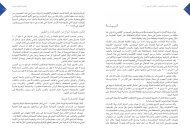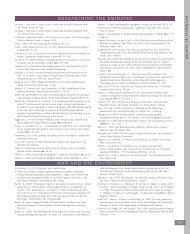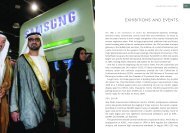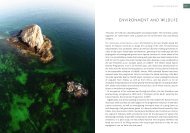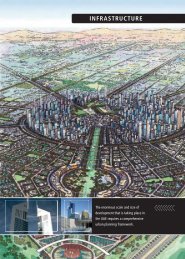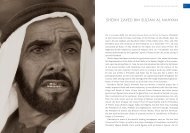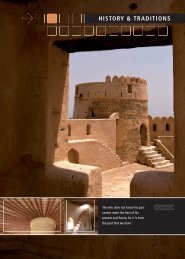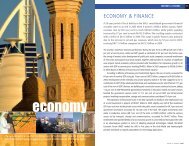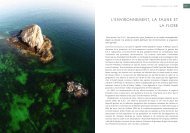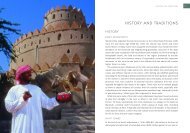Create successful ePaper yourself
Turn your PDF publications into a flip-book with our unique Google optimized e-Paper software.
150UNITED ARAB EMIRATES YEARBOOK 2006<strong>ECONOMIC</strong> <strong>DEVELOPMENT</strong>151Projects costing in excess of US$4 billion are under execution and due forcompletion progressively during the years 2007/08. Salient features of some ofthese major projects are highlighted below.(i) The Offshore Gas Development Phase III (OGD – III) Project is designed toprocess 1306 mmscf/d of condensate rich gas (Thamama ‘F’) at Habshan andto produce 11,800 t/d NGL (including 3400 t/d ethane) and 130,000 b/dcondensate. Residue gas will be re-injected back into the reservoir for pressuremaintenance purposes (gas cycling).Main facilities will include two trains each of inlet separation, condensatestabilisation, gas treatment and NGL recovery units. The project will also includeinstallation of a gas re-injection system and a separate NGL pipeline from Habshanto Ruwais, apart from various utilities and offsite facilities.The EPC Contract for OGD III Project was awarded to M/S Bechtel (UK) inDecember 2004 and the work is expected to be completed by April 2008.(ii) The third NGL train at Ruwais is designed to process an additional 24,400 t/dof NGL produced from OGD-III, AGD-II and other projects and to produce about6400 t/d of raw ethane for transfer to the petrochemical plant at Ruwais (Borouge),6000 t/d each of propane and butane and 5800 t/d of pentane plus products.The project essentially comprises a new NGL fractionation train and new storagetanks for propane, butane and pentane-plus together with some new jetty andancilliary facilities. An EPC contract was awarded to M/S Snamprogetti (Italy) inMarch 2005 and is due for completion by May 2008.(iii) The Asab Gas Development – Phase II (AGD-II) is designed to recover6400 t/d of NGL from the sour condensate rich gas from the existing Asab GasPlant (AGP). Residue gas will be re-injected back into the reservoir for pressuremaintenance purposes (gas cycling).Main facilities include two trains each of gas treatment and NGL recovery units,apart from a new NGL pipeline from Asab to Habshan and the required utilitiesand offsite facilities. An EPC contract was awarded to Bechtel in July 2005 and isdue for completion by September 2008. This is the last of the five major projectswithin the overall scheme of onshore gas development initiated by ANDOC.(iv) The Habshan Gas Complex Expansion involves installation of an additionalgas processing train at Habshan (capacity up to 360 mmscf/d), to process additionalnon-associated or associated gas, in particular from the ADCO crude oil expansionproject at Bab. It will also process high-pressure gas from Buhasa to achieveoperational flexibility between Buhasa and Habshan. It includes increasing thegas injection capacity at Habshan from 1100 mmscf/d to 1525 mmscf/d and theinstallation of an additional pair of sulphur recovery units (SRU).(v) The Offshore Associated Gas Project (OAG) envisages transporting the excessoffshore associated from Das Island through a 200-kilometre-long, 24-inch diameteroffshore / onshore pipeline and to process it at Habshan. It will establish a strategiclink between the offshore and onshore facilities.Pre-FEED study for the project was completed by M/S Fluor (USA) in September2004. The Front-End Engineering and Design (FEED) contract was awarded toFluor (UK) in February 2005 and was scheduled for completion by November2005. EPC implementation of the project is planned to be achieved by the secondquarter of 2008.Other GASCO projects include upgrading of facilities at Buhasa, an Asab andBab integrated control system, and the Ruwais GUP power interconnection.ADGASOffshore gas development is also of crucial importance to Abu Dhabi’s economy,with current work being focused on increasing efficiency with regard to extractionrates. Most of the gas produced offshore is supplied to the Abu Dhabi GasLiquefaction Company’s (ADGAS) liquefaction plant on Das Island. In December2004 ADGAS contracted with German company Siemens to modernise and expandthe power supply system at its liquefaction plant.From the outset all the ADGAS plant’s LNG and most of its LPG were purchasedby Tokyo Electric Power Company (TEPCO) under a 20-year contract that tookeffect in 1977 and provided for TEPCO to lift 2 million t/y of LNG and 500,000 t/yof LPG. In 1990 the company decided to more than double the capacity of its plantto 5.4 million t/y of LNG, 1.7 million t/y of LPG and 535,000 t/y of pentane-plus. Theexpansion entailed the installation in 1994 of a third liquefaction train with acapacity of 2.3 million t/y of LNG and 250,000 t/y of LPG. Like the original units,the third liquefaction train has consistently operated in excess of its design capacity.The plant’s LNG capacity was further increased in August 2001, when ADGAScompleted the revamp of the propane compressor serving its third liquefactiontrain, boosting its production capacity from 320 tons/hour to 380 tons/hour.In early 2002, the company signed a FEED contract with the Chiyoda Corporationfor an additional LPG train with a capacity of approximately 1 million t/y. Shortlyafterwards, in October 2002, ADGAS signed an agreement with BP Gas MarketingCompany for the supply of up to 750,000 t/y of LNG. The contract runs to theend of 2005, and could be extended to the end of 2007, depending on BP’srequirements. Whilst TEPCO remains ADGAS’s major customer, marketingdevelopment has considerably broadened the client base in recent years. Inaddition to the sales to BP mentioned above, the company has sold its gas productsto European, American and Asian clients.One major offshore gas development project completed in the latter part of 2004entailed further development of the Khuff gas reservoirs under the Abu al-Bukhoosh(ABK) field, 45 kilometres north-west of Das Island. It provides for the volume



